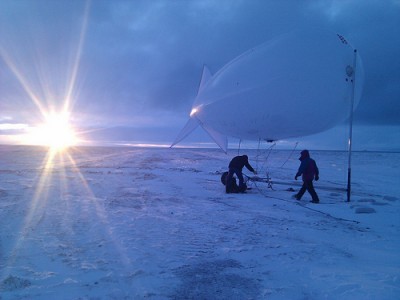ALTOS Overview

NOTE: An unfortunate incident in the early stages of ALTOS has resulted in the campaign being terminated. During one of the tethered balloon’s initial flights, its primary and secondary tethers broke, and the instrument payload landed in the ocean where it could not be safely retrieved. If replacement instruments can be obtained in the next few months, there is a possibility the campaign could restart in the spring.
The ALTOS campaign will take place October-December 2010, at Oliktok Point on Alaska’s North Slope. ARM scientists will conduct regular in situ cloud and aerosol measurements of the Arctic lower troposphere using a tethered balloon system (TBS) equipped with state-of-the-art atmospheric state, radiative transfer, cloud microphysics, and aerosol sampling devices. The TBS will be complemented with a full array of ground based instruments.
The Arctic has been identified as one of the regions most sensitive to climate change. ALTOS will provide important data sets of Arctic boundary layer cloud microphysics and radiative transfer for the study of the ice-albedo feedback in the cloudy Arctic lower troposphere. The aim is to collect comprehensive observations of Arctic boundary layer cloud formation, development, and dissipation, cataloguing boundary layer microphysical parameterizations over a wide range Arctic atmospheric conditions.
Data obtained during the ALTOS campaign will provide a statistically significant set of observed in situ cloud properties for validating retrieval algorithms, and help scientists reduce the uncertainty in the radiative forcing and heating rates on hourly time scales. These data will also help researchers gain a better understanding of the driving processes that control climate changes and determine the final state of the Arctic climate system.
Keep up with the Atmospheric Observer
Updates on ARM news, events, and opportunities delivered to your inbox
ARM User Profile
ARM welcomes users from all institutions and nations. A free ARM user account is needed to access ARM data.


















